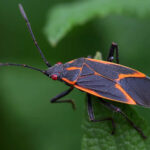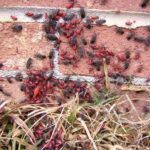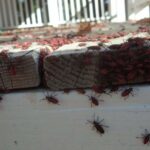 In some areas of the country, boxelder bugs are a major nuisance for homeowners. These bugs swarm all over homes in the fall and make their way inside. And when we say “swarm,” we really mean it! They gather by the dozens all over the house, totally unconcerned by the presence of people, pets, and any other potential predators.
In some areas of the country, boxelder bugs are a major nuisance for homeowners. These bugs swarm all over homes in the fall and make their way inside. And when we say “swarm,” we really mean it! They gather by the dozens all over the house, totally unconcerned by the presence of people, pets, and any other potential predators.
Boxelder bugs are insects native to the western U.S. They can become a major nuisance in the late summer and fall when they seek out sites for overwintering. During that time, they often gather in large numbers on the sunny side of trees and buildings.
Boxelder bugs are considered strong and agile fliers, sometimes traveling several miles from the trees where they hatched as they seek out food sources and places to overwinter.
Boxelder bugs won’t bite, but on rare occasions, they may prick you with a sharp mouthpart. As they are considered “true bugs,” they have evolved to suck nutrients from their food, rather than biting and tearing it with mandibles. Boxelder bugs do not have the ability to sting, either.
If your pet is prone to eating bugs, try to steer them clear of tasting a boxelder bug. As a defense against predators, these insects are said have an extremely foul taste. If your dog does eat a boxelder bug, expect that it may vomit in a short time and take preparations.
Boxelder bugs eat by sucking the juices out of plants. In particular, they feed upon the juice contained in the seeds of boxelder trees and other trees in the maple family. Even in large numbers, boxelder bugs seem to do little damage to these trees.
During their normal activity, boxelder bugs don’t emit any odor. However, when disturbed or smashed, they will release a pungent (and bad tasting) compound to discourage predators. This, along with their orange or red markings, makes it easy for most predators to remember to avoid eating these bugs.

Boxelder bugs lay their eggs on the trunks, branches, and leaves of their food source. They do not lay eggs in or on houses or other structures. After hatching as nymphs 10 to 14 days later, they will molt five times throughout the spring, summer and fall months.
Naturally, boxelder bugs are attracted to their food source – the seeds of the maple tree family. In the spring, they feed on the juice trapped in ungerminated seeds that have fallen off trees. As new seeds develop throughout the summer, they feed on those. Further, boxelder bugs are attracted to the areas where they can find shelter for the coming winter. To stay warm, they congregate on brick or stucco facades and on the surfaces of any south- or west-facing structures that catch significant amounts of sunlight.
In some years, the sheer number of boxelder bugs can make the task of controlling them seem daunting. Still, several simple steps can be taken to limit their ability to get inside.
- Remove Boxelder Bug Food Sources
- Seal Gaps in Your Home
- Check or Install Screens